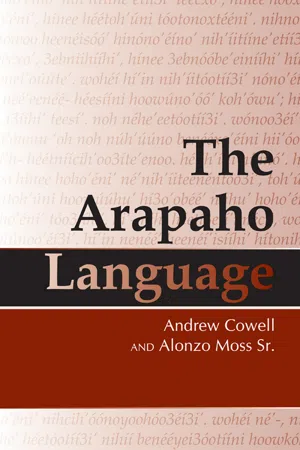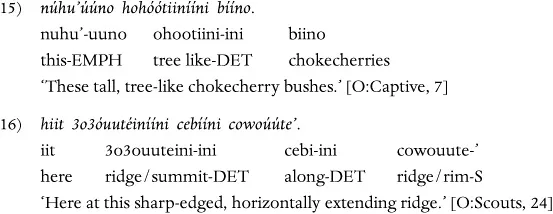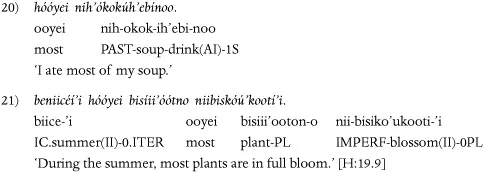![]()
14
THE NOUN PHRASE
In the following section, we will examine the larger noun phrase, consisting of multiple words beyond the simple noun word. The additional forms common in noun phrases include independent adjectival modifiers, demonstratives, and pseudo-verbal presentational forms.
14.1 ADJECTIVAL MODIFICATION
14.1.1 Prenouns and Noun Initials
Prenoun-noun combinations show many similarities to preverb–verb stem combinations in Arapaho, and similarly, noun initial and final combinations resemble verb initial and final constructions. As seen in chapter 4, many common lexical items consist of these combinations.
However, it is also fairly common for these kinds of modifier + base noun constructions to be used even when they do not form fully lexicalized expressions. This seems to occur with common semantic pairings, and primarily with /ecex/ (‘little’), /eebet/ (‘big’), colors, and a few other prototypical adjectival modifers.
14.1.2 Independent Verbs and Particles as Adjectival Modifiers
Adjective-type roots can also be expressed independently of the noun word when they are particularly salient. Contrast the following with examples 3–5 above:
hé’ihcih’itétowuu.
e’ih-cih-itet- owuu
NPAST-to here-reach/get to(TI)-3PL
big rivers.’ [R:The Splitting of the Tribes]
eesitei’oo-’
what-strong(II-)0S
‘But I’m just saying a little bit that will be beneficial and provide strength [to the tribe].’ [R:Speech]
The most common expressions of this type involve preposed verbs. The verb stem type agrees with the following noun in gender (i.e., II verb + NI, AI verb + NA). Note that the preposed verbal forms as in example 6 are best analyzed as relative clauses (see 17.1). The use of these clauses as (syntactic) adjectives is the only situation in which relative clauses occur prior to the head noun in Arapaho.
As with verb phrases, not only especially salient morphemes but also less common ones are expressed as independent forms. In this case as well, an adjective-like, stative verb is used preceding the noun in question:
Alonzo Moss states that
bo’o3 onohoe (‘red book’) is not acceptable here, although
heebét-o3onohóe (‘big book’) would be.
Possessed forms can be modified in the same manner:
Preposed modifying verbs can be inflected in a variety of different ways:
woxhooxew-ii
horse-PL
‘I will capture [from him] who knows how many horses.’ [O:Scouts, 33]
It is important to note that not just verbs but any semantically suitable element can be preposed to the noun to create an adjectival construction. This includes particles and adverbials (as in example 7).
Particle:
Adverbial particle:
In some cases, the adjectival relative clause is placed after the head noun. This always occurs when the relative clause involves more than a single word. In the context of the discussion in this section, it is worth noting that it also seems very rare for relative clauses to be preposed to the noun when the modifying verb is non-stative:
14.1.3 Semi-independent /ini/ Construction
There is an additional adjective-noun construction, in which a prenoun (but not noun initials) takes the suffix /ini/ and is detached from the noun. As when this construction is used with verbs, this process only marginally creates an independent word, since the basic morphosyntactic structure of the noun is maintained (see 9.15 for further details):
This construction is used either for emphatic purposes, when no suitable independent verb form is available to create an independent adjective (as with /cebi /), or when the modifying element is unusual and not attached to the noun stem for this reason (unlike more common prenouns).
14.1.4 Adjective Incorporation into Verb Word
Finally, with regard to adjectival modification, it should be pointed out as an aside that many modifications that in more analytic languages are part of the noun phrase are attached to the verb as preverbs in Arapaho. We have already seen this in the case of the ‘all’ modifiers (section 9.4). In many cases, this is because the nominal element is itself incorporated in the verb, either directly (example 18) or in the underlying semantics of the stem (example 17), but this is not necessarily the case, especially with quantifiers (as in example 19). Examples are:
18) heetwoonotiibeet.
eti-woon-otiibee-t
IC.FUT-new-possess car(AI)-3S
‘He is buying a new car.’ [J:I.Family]
14.1.5 Particles: Quantification, Distribution, and so forth
In Arapaho, several quantifiers that modify nouns occur as particles, which can function either as indefinite pronouns or adjectives. When the noun is an independent form, the particle precedes the noun, whereas when the noun is incorporated into the verb, the particle is preposed to the verb.
These particles include:
14.2 DEMONSTRATIVES
Arapaho has a basic dual ‘this’ and ‘that’ demonstrative system. Arapaho has no definite articles, and the demonstratives meaning ‘this’ and ‘that’ are relatively weaker in force than the English gloss suggests. Although in some instances they do have full demonstrative force, on many occasions they simply indicate that the noun in question is definite, and so they can be glossed as ‘the’. Núhu’ ‘this’ seems to be the default form for ‘the’, but hínee ‘that’ is also used in this way, so that Arapaho to a certain extent has a dual definite article system, indicating ‘the (here)’ and ‘the (there)’.
There are, in fact, two forms for ‘this’:
Strictly speaking, néhe’ is used for proximate nouns, whereas núhu’ is used for obviative and inanimate nouns (which include all clauses treated as nominals). However, in the usage of many speakers, this distinction is not fully observed. Even in the stories of Paul Moss, Moss adheres to this distinction more strictly in some stories than in others. In the fourth text in the anthology, “The Captive,” the distinction is quite clear, and there are numerous clear-cut oppositions between néhe’ and núhu’, often in the same strophe. The “emphatic” forms of these demonstratives are relatively rare.
Even in earlier texts, the forms núhu’úúno and néhe’ééno are rare, and this is certainly the case today. It is perhaps incorrect to label them “emphatic” forms, as they often seem to function somewhat like indefinite or approximative forms. In “Tangled Hair,” collected by Michelson, is the following sentence:
In a prayer recorded by Kroeber is:
i–niixooton-i
3S–go through(AI.PART)–S
‘This one who is serving [them], let his trave...





















